Application of Membrane Technology in Water Treatment Report
VerifiedAdded on 2022/05/23
|12
|3499
|269
Report
AI Summary
This report provides a comprehensive overview of membrane technology applications in water treatment. It begins with an abstract summarizing the key topics, including the advantages of membrane-coupled bioreactors and direct membrane separation. The introduction emphasizes the importance of water and the role of membrane processes like ultrafiltration, microfiltration, reverse osmosis, and nanofiltration in advanced water treatment and desalination. The discussion section covers recent developments in inorganic membranes (mesoporous ceramic membranes), organic membranes (integrally skinned membranes and TFC membranes), and nanotechnology-based membrane materials (nanostructured ceramic membranes, inorganic–organic membranes). It then addresses current challenges in water treatment, including technical issues like product quality and productivity (fouling), as well as socio-political challenges such as climate change and the Millennium Development Goals. Finally, the report explores methods and designs to overcome these challenges, focusing on desalination techniques (minimizing GHG emissions, membrane distillation, and forward osmosis) and MBRs (membrane bioreactors), with discussions on low-carbon solutions and wastewater pre-concentration. The report emphasizes the need for innovation and optimization in membrane technology to address global water challenges.
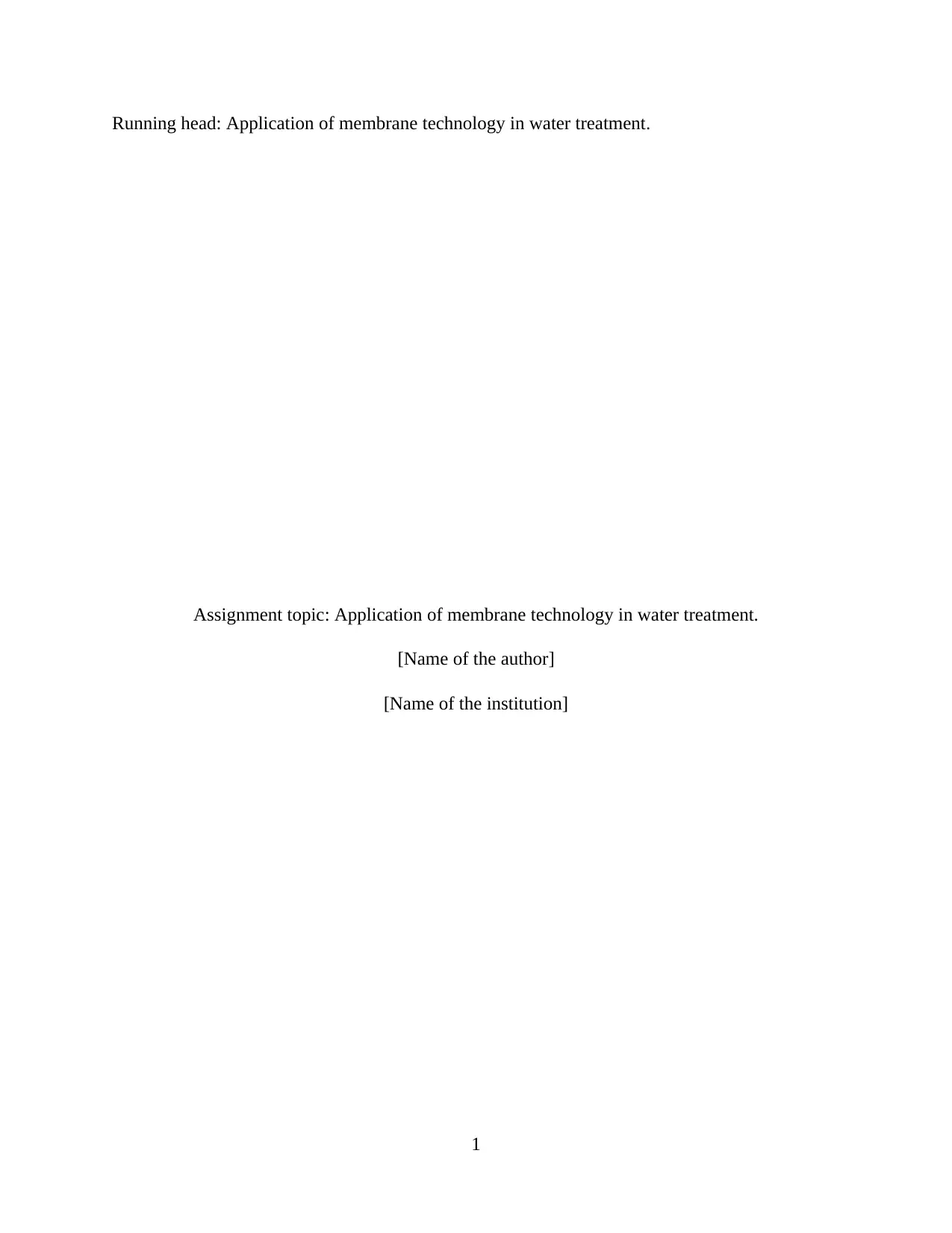
Running head: Application of membrane technology in water treatment.
Assignment topic: Application of membrane technology in water treatment.
[Name of the author]
[Name of the institution]
1
Assignment topic: Application of membrane technology in water treatment.
[Name of the author]
[Name of the institution]
1
Paraphrase This Document
Need a fresh take? Get an instant paraphrase of this document with our AI Paraphraser
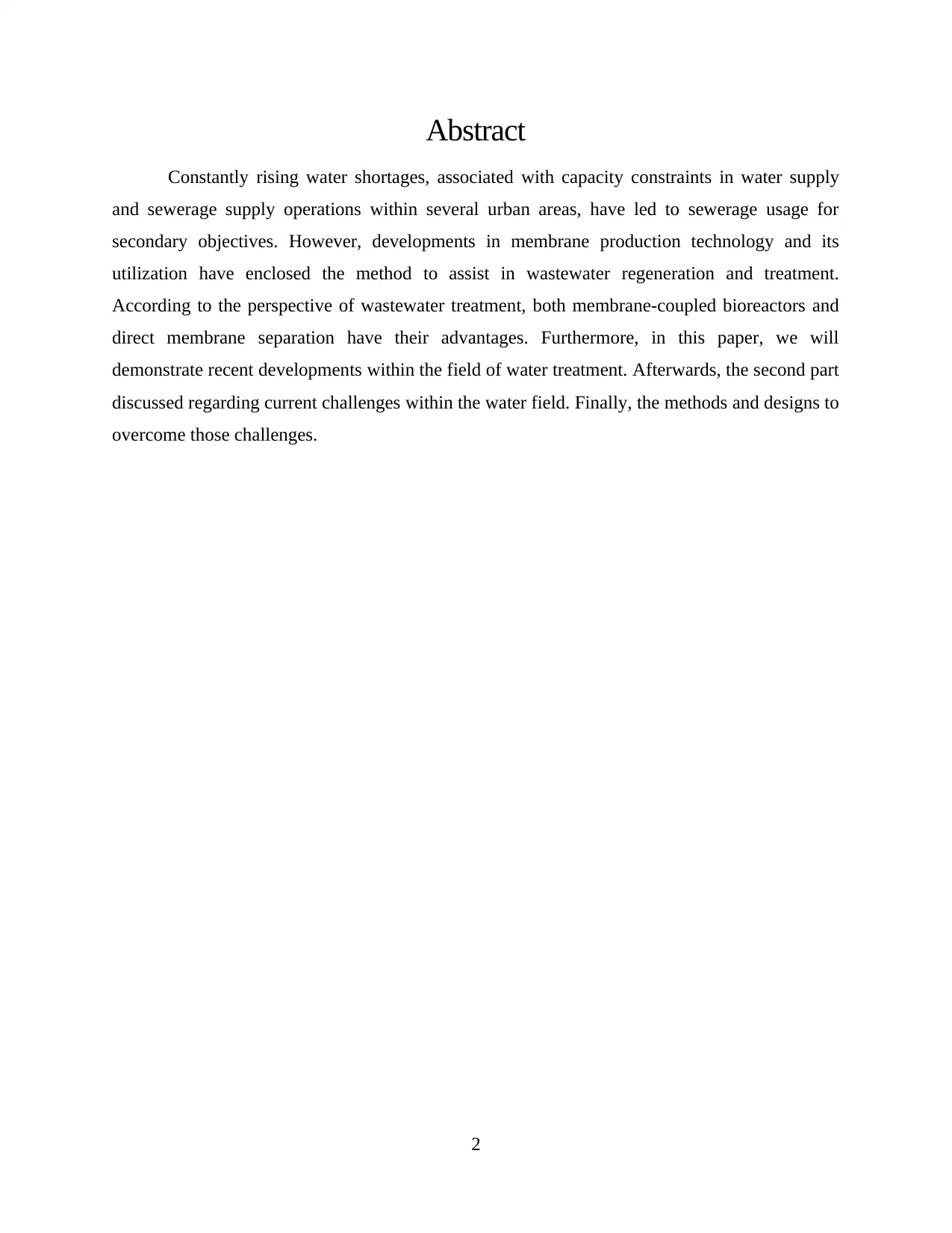
Abstract
Constantly rising water shortages, associated with capacity constraints in water supply
and sewerage supply operations within several urban areas, have led to sewerage usage for
secondary objectives. However, developments in membrane production technology and its
utilization have enclosed the method to assist in wastewater regeneration and treatment.
According to the perspective of wastewater treatment, both membrane-coupled bioreactors and
direct membrane separation have their advantages. Furthermore, in this paper, we will
demonstrate recent developments within the field of water treatment. Afterwards, the second part
discussed regarding current challenges within the water field. Finally, the methods and designs to
overcome those challenges.
2
Constantly rising water shortages, associated with capacity constraints in water supply
and sewerage supply operations within several urban areas, have led to sewerage usage for
secondary objectives. However, developments in membrane production technology and its
utilization have enclosed the method to assist in wastewater regeneration and treatment.
According to the perspective of wastewater treatment, both membrane-coupled bioreactors and
direct membrane separation have their advantages. Furthermore, in this paper, we will
demonstrate recent developments within the field of water treatment. Afterwards, the second part
discussed regarding current challenges within the water field. Finally, the methods and designs to
overcome those challenges.
2
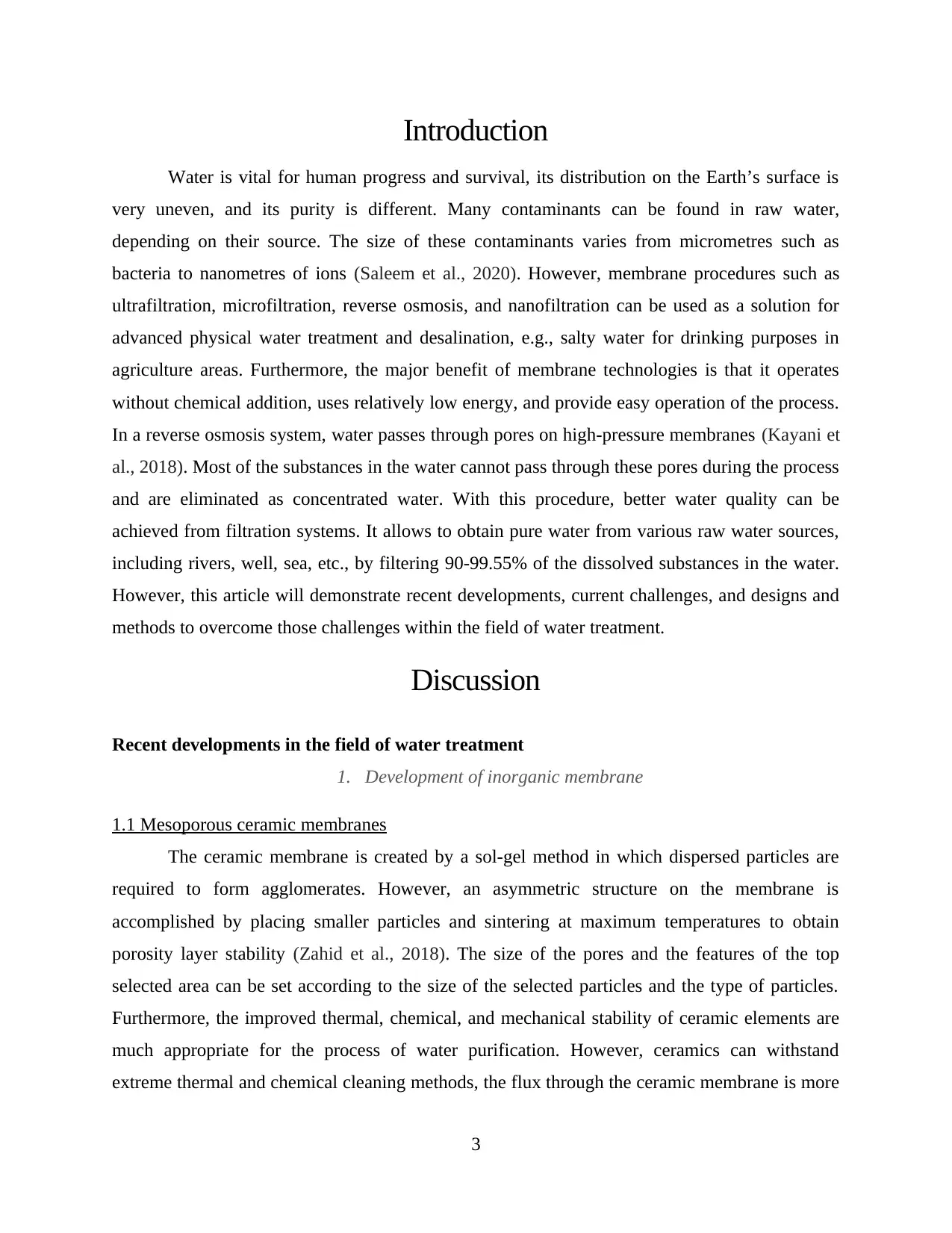
Introduction
Water is vital for human progress and survival, its distribution on the Earth’s surface is
very uneven, and its purity is different. Many contaminants can be found in raw water,
depending on their source. The size of these contaminants varies from micrometres such as
bacteria to nanometres of ions (Saleem et al., 2020). However, membrane procedures such as
ultrafiltration, microfiltration, reverse osmosis, and nanofiltration can be used as a solution for
advanced physical water treatment and desalination, e.g., salty water for drinking purposes in
agriculture areas. Furthermore, the major benefit of membrane technologies is that it operates
without chemical addition, uses relatively low energy, and provide easy operation of the process.
In a reverse osmosis system, water passes through pores on high-pressure membranes (Kayani et
al., 2018). Most of the substances in the water cannot pass through these pores during the process
and are eliminated as concentrated water. With this procedure, better water quality can be
achieved from filtration systems. It allows to obtain pure water from various raw water sources,
including rivers, well, sea, etc., by filtering 90-99.55% of the dissolved substances in the water.
However, this article will demonstrate recent developments, current challenges, and designs and
methods to overcome those challenges within the field of water treatment.
Discussion
Recent developments in the field of water treatment
1. Development of inorganic membrane
1.1 Mesoporous ceramic membranes
The ceramic membrane is created by a sol-gel method in which dispersed particles are
required to form agglomerates. However, an asymmetric structure on the membrane is
accomplished by placing smaller particles and sintering at maximum temperatures to obtain
porosity layer stability (Zahid et al., 2018). The size of the pores and the features of the top
selected area can be set according to the size of the selected particles and the type of particles.
Furthermore, the improved thermal, chemical, and mechanical stability of ceramic elements are
much appropriate for the process of water purification. However, ceramics can withstand
extreme thermal and chemical cleaning methods, the flux through the ceramic membrane is more
3
Water is vital for human progress and survival, its distribution on the Earth’s surface is
very uneven, and its purity is different. Many contaminants can be found in raw water,
depending on their source. The size of these contaminants varies from micrometres such as
bacteria to nanometres of ions (Saleem et al., 2020). However, membrane procedures such as
ultrafiltration, microfiltration, reverse osmosis, and nanofiltration can be used as a solution for
advanced physical water treatment and desalination, e.g., salty water for drinking purposes in
agriculture areas. Furthermore, the major benefit of membrane technologies is that it operates
without chemical addition, uses relatively low energy, and provide easy operation of the process.
In a reverse osmosis system, water passes through pores on high-pressure membranes (Kayani et
al., 2018). Most of the substances in the water cannot pass through these pores during the process
and are eliminated as concentrated water. With this procedure, better water quality can be
achieved from filtration systems. It allows to obtain pure water from various raw water sources,
including rivers, well, sea, etc., by filtering 90-99.55% of the dissolved substances in the water.
However, this article will demonstrate recent developments, current challenges, and designs and
methods to overcome those challenges within the field of water treatment.
Discussion
Recent developments in the field of water treatment
1. Development of inorganic membrane
1.1 Mesoporous ceramic membranes
The ceramic membrane is created by a sol-gel method in which dispersed particles are
required to form agglomerates. However, an asymmetric structure on the membrane is
accomplished by placing smaller particles and sintering at maximum temperatures to obtain
porosity layer stability (Zahid et al., 2018). The size of the pores and the features of the top
selected area can be set according to the size of the selected particles and the type of particles.
Furthermore, the improved thermal, chemical, and mechanical stability of ceramic elements are
much appropriate for the process of water purification. However, ceramics can withstand
extreme thermal and chemical cleaning methods, the flux through the ceramic membrane is more
3
⊘ This is a preview!⊘
Do you want full access?
Subscribe today to unlock all pages.

Trusted by 1+ million students worldwide
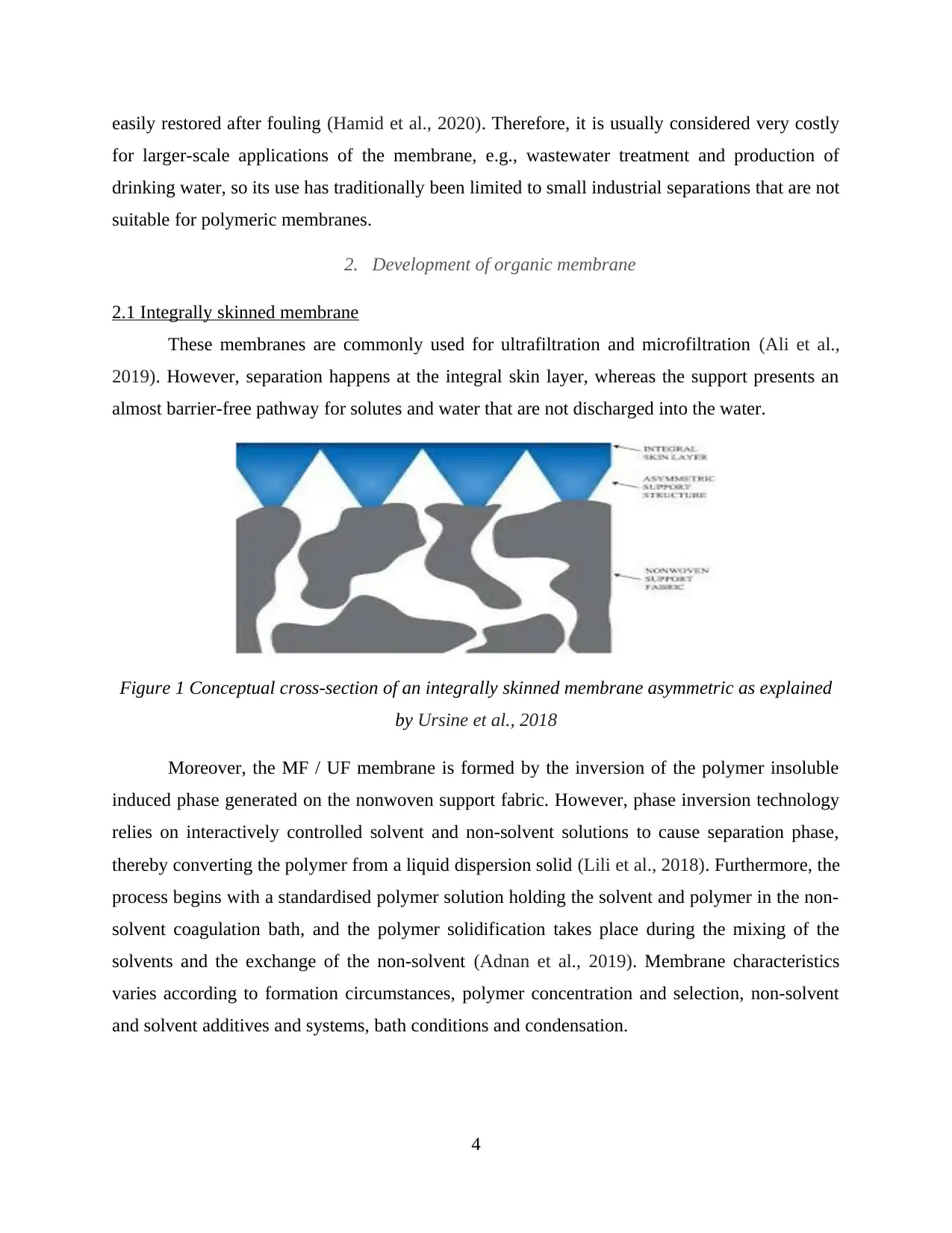
easily restored after fouling (Hamid et al., 2020). Therefore, it is usually considered very costly
for larger-scale applications of the membrane, e.g., wastewater treatment and production of
drinking water, so its use has traditionally been limited to small industrial separations that are not
suitable for polymeric membranes.
2. Development of organic membrane
2.1 Integrally skinned membrane
These membranes are commonly used for ultrafiltration and microfiltration (Ali et al.,
2019). However, separation happens at the integral skin layer, whereas the support presents an
almost barrier-free pathway for solutes and water that are not discharged into the water.
Figure 1 Conceptual cross-section of an integrally skinned membrane asymmetric as explained
by Ursine et al., 2018
Moreover, the MF / UF membrane is formed by the inversion of the polymer insoluble
induced phase generated on the nonwoven support fabric. However, phase inversion technology
relies on interactively controlled solvent and non-solvent solutions to cause separation phase,
thereby converting the polymer from a liquid dispersion solid (Lili et al., 2018). Furthermore, the
process begins with a standardised polymer solution holding the solvent and polymer in the non-
solvent coagulation bath, and the polymer solidification takes place during the mixing of the
solvents and the exchange of the non-solvent (Adnan et al., 2019). Membrane characteristics
varies according to formation circumstances, polymer concentration and selection, non-solvent
and solvent additives and systems, bath conditions and condensation.
4
for larger-scale applications of the membrane, e.g., wastewater treatment and production of
drinking water, so its use has traditionally been limited to small industrial separations that are not
suitable for polymeric membranes.
2. Development of organic membrane
2.1 Integrally skinned membrane
These membranes are commonly used for ultrafiltration and microfiltration (Ali et al.,
2019). However, separation happens at the integral skin layer, whereas the support presents an
almost barrier-free pathway for solutes and water that are not discharged into the water.
Figure 1 Conceptual cross-section of an integrally skinned membrane asymmetric as explained
by Ursine et al., 2018
Moreover, the MF / UF membrane is formed by the inversion of the polymer insoluble
induced phase generated on the nonwoven support fabric. However, phase inversion technology
relies on interactively controlled solvent and non-solvent solutions to cause separation phase,
thereby converting the polymer from a liquid dispersion solid (Lili et al., 2018). Furthermore, the
process begins with a standardised polymer solution holding the solvent and polymer in the non-
solvent coagulation bath, and the polymer solidification takes place during the mixing of the
solvents and the exchange of the non-solvent (Adnan et al., 2019). Membrane characteristics
varies according to formation circumstances, polymer concentration and selection, non-solvent
and solvent additives and systems, bath conditions and condensation.
4
Paraphrase This Document
Need a fresh take? Get an instant paraphrase of this document with our AI Paraphraser
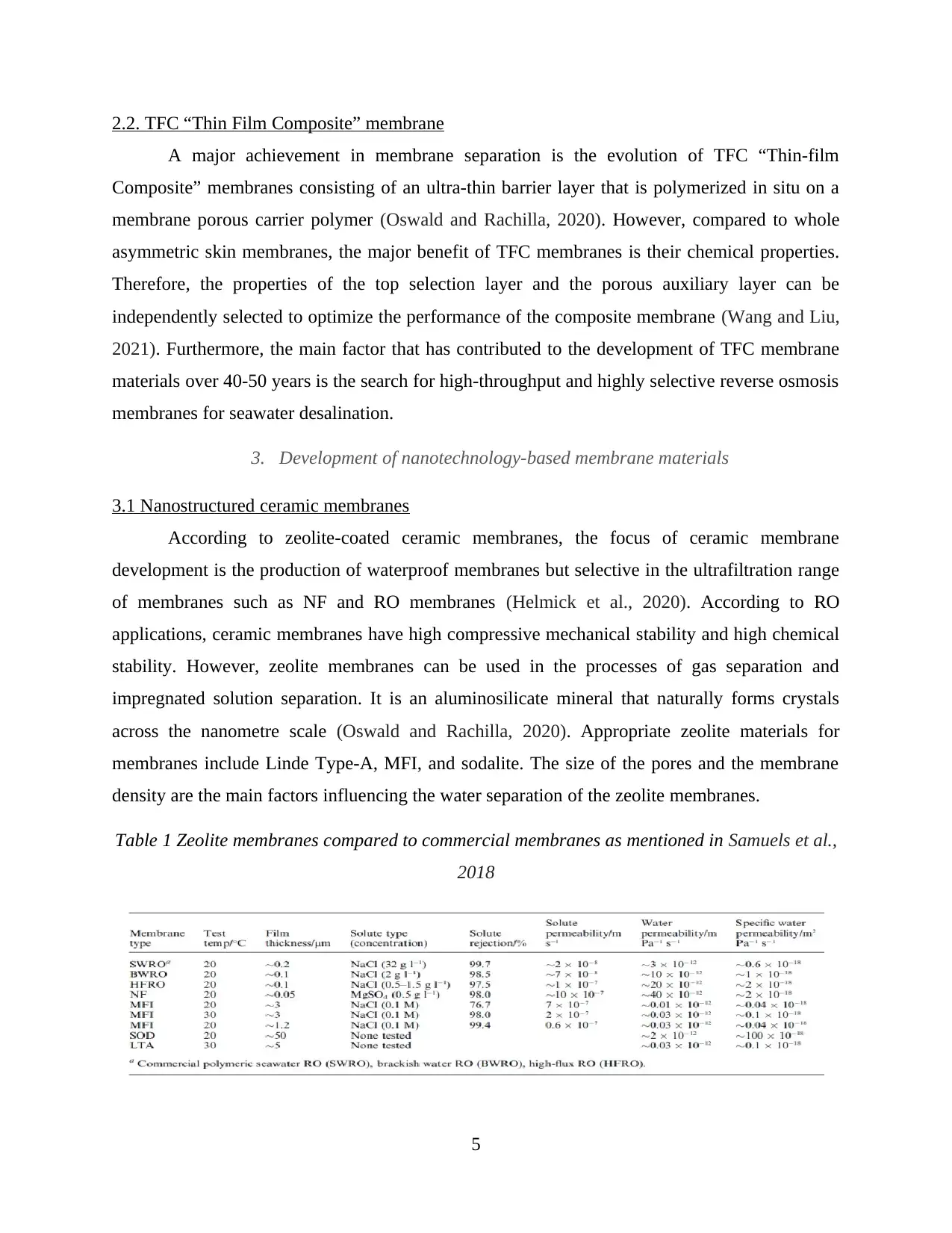
2.2. TFC “Thin Film Composite” membrane
A major achievement in membrane separation is the evolution of TFC “Thin-film
Composite” membranes consisting of an ultra-thin barrier layer that is polymerized in situ on a
membrane porous carrier polymer (Oswald and Rachilla, 2020). However, compared to whole
asymmetric skin membranes, the major benefit of TFC membranes is their chemical properties.
Therefore, the properties of the top selection layer and the porous auxiliary layer can be
independently selected to optimize the performance of the composite membrane (Wang and Liu,
2021). Furthermore, the main factor that has contributed to the development of TFC membrane
materials over 40-50 years is the search for high-throughput and highly selective reverse osmosis
membranes for seawater desalination.
3. Development of nanotechnology-based membrane materials
3.1 Nanostructured ceramic membranes
According to zeolite-coated ceramic membranes, the focus of ceramic membrane
development is the production of waterproof membranes but selective in the ultrafiltration range
of membranes such as NF and RO membranes (Helmick et al., 2020). According to RO
applications, ceramic membranes have high compressive mechanical stability and high chemical
stability. However, zeolite membranes can be used in the processes of gas separation and
impregnated solution separation. It is an aluminosilicate mineral that naturally forms crystals
across the nanometre scale (Oswald and Rachilla, 2020). Appropriate zeolite materials for
membranes include Linde Type-A, MFI, and sodalite. The size of the pores and the membrane
density are the main factors influencing the water separation of the zeolite membranes.
Table 1 Zeolite membranes compared to commercial membranes as mentioned in Samuels et al.,
2018
5
A major achievement in membrane separation is the evolution of TFC “Thin-film
Composite” membranes consisting of an ultra-thin barrier layer that is polymerized in situ on a
membrane porous carrier polymer (Oswald and Rachilla, 2020). However, compared to whole
asymmetric skin membranes, the major benefit of TFC membranes is their chemical properties.
Therefore, the properties of the top selection layer and the porous auxiliary layer can be
independently selected to optimize the performance of the composite membrane (Wang and Liu,
2021). Furthermore, the main factor that has contributed to the development of TFC membrane
materials over 40-50 years is the search for high-throughput and highly selective reverse osmosis
membranes for seawater desalination.
3. Development of nanotechnology-based membrane materials
3.1 Nanostructured ceramic membranes
According to zeolite-coated ceramic membranes, the focus of ceramic membrane
development is the production of waterproof membranes but selective in the ultrafiltration range
of membranes such as NF and RO membranes (Helmick et al., 2020). According to RO
applications, ceramic membranes have high compressive mechanical stability and high chemical
stability. However, zeolite membranes can be used in the processes of gas separation and
impregnated solution separation. It is an aluminosilicate mineral that naturally forms crystals
across the nanometre scale (Oswald and Rachilla, 2020). Appropriate zeolite materials for
membranes include Linde Type-A, MFI, and sodalite. The size of the pores and the membrane
density are the main factors influencing the water separation of the zeolite membranes.
Table 1 Zeolite membranes compared to commercial membranes as mentioned in Samuels et al.,
2018
5
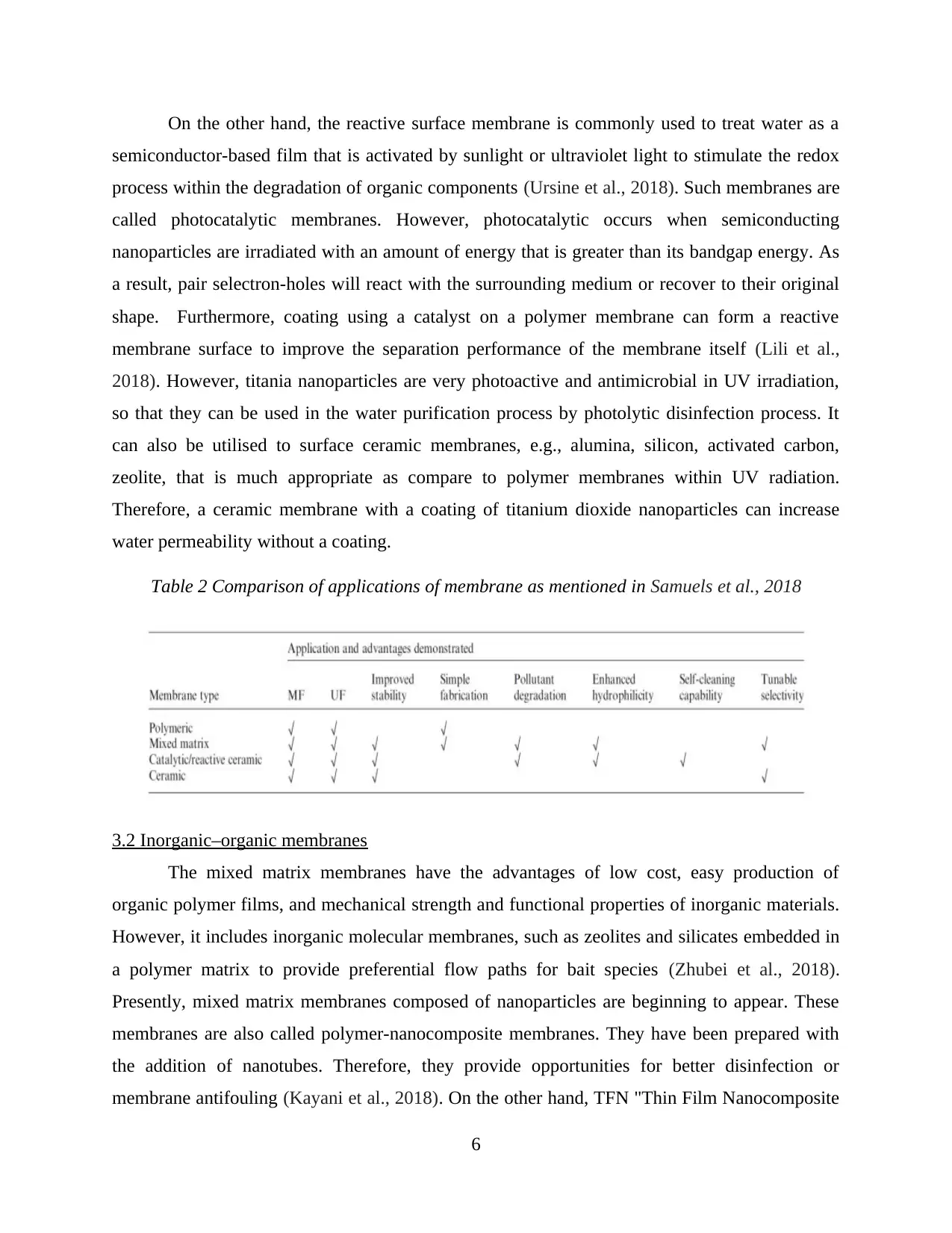
On the other hand, the reactive surface membrane is commonly used to treat water as a
semiconductor-based film that is activated by sunlight or ultraviolet light to stimulate the redox
process within the degradation of organic components (Ursine et al., 2018). Such membranes are
called photocatalytic membranes. However, photocatalytic occurs when semiconducting
nanoparticles are irradiated with an amount of energy that is greater than its bandgap energy. As
a result, pair selectron-holes will react with the surrounding medium or recover to their original
shape. Furthermore, coating using a catalyst on a polymer membrane can form a reactive
membrane surface to improve the separation performance of the membrane itself (Lili et al.,
2018). However, titania nanoparticles are very photoactive and antimicrobial in UV irradiation,
so that they can be used in the water purification process by photolytic disinfection process. It
can also be utilised to surface ceramic membranes, e.g., alumina, silicon, activated carbon,
zeolite, that is much appropriate as compare to polymer membranes within UV radiation.
Therefore, a ceramic membrane with a coating of titanium dioxide nanoparticles can increase
water permeability without a coating.
Table 2 Comparison of applications of membrane as mentioned in Samuels et al., 2018
3.2 Inorganic–organic membranes
The mixed matrix membranes have the advantages of low cost, easy production of
organic polymer films, and mechanical strength and functional properties of inorganic materials.
However, it includes inorganic molecular membranes, such as zeolites and silicates embedded in
a polymer matrix to provide preferential flow paths for bait species (Zhubei et al., 2018).
Presently, mixed matrix membranes composed of nanoparticles are beginning to appear. These
membranes are also called polymer-nanocomposite membranes. They have been prepared with
the addition of nanotubes. Therefore, they provide opportunities for better disinfection or
membrane antifouling (Kayani et al., 2018). On the other hand, TFN "Thin Film Nanocomposite
6
semiconductor-based film that is activated by sunlight or ultraviolet light to stimulate the redox
process within the degradation of organic components (Ursine et al., 2018). Such membranes are
called photocatalytic membranes. However, photocatalytic occurs when semiconducting
nanoparticles are irradiated with an amount of energy that is greater than its bandgap energy. As
a result, pair selectron-holes will react with the surrounding medium or recover to their original
shape. Furthermore, coating using a catalyst on a polymer membrane can form a reactive
membrane surface to improve the separation performance of the membrane itself (Lili et al.,
2018). However, titania nanoparticles are very photoactive and antimicrobial in UV irradiation,
so that they can be used in the water purification process by photolytic disinfection process. It
can also be utilised to surface ceramic membranes, e.g., alumina, silicon, activated carbon,
zeolite, that is much appropriate as compare to polymer membranes within UV radiation.
Therefore, a ceramic membrane with a coating of titanium dioxide nanoparticles can increase
water permeability without a coating.
Table 2 Comparison of applications of membrane as mentioned in Samuels et al., 2018
3.2 Inorganic–organic membranes
The mixed matrix membranes have the advantages of low cost, easy production of
organic polymer films, and mechanical strength and functional properties of inorganic materials.
However, it includes inorganic molecular membranes, such as zeolites and silicates embedded in
a polymer matrix to provide preferential flow paths for bait species (Zhubei et al., 2018).
Presently, mixed matrix membranes composed of nanoparticles are beginning to appear. These
membranes are also called polymer-nanocomposite membranes. They have been prepared with
the addition of nanotubes. Therefore, they provide opportunities for better disinfection or
membrane antifouling (Kayani et al., 2018). On the other hand, TFN "Thin Film Nanocomposite
6
⊘ This is a preview!⊘
Do you want full access?
Subscribe today to unlock all pages.

Trusted by 1+ million students worldwide
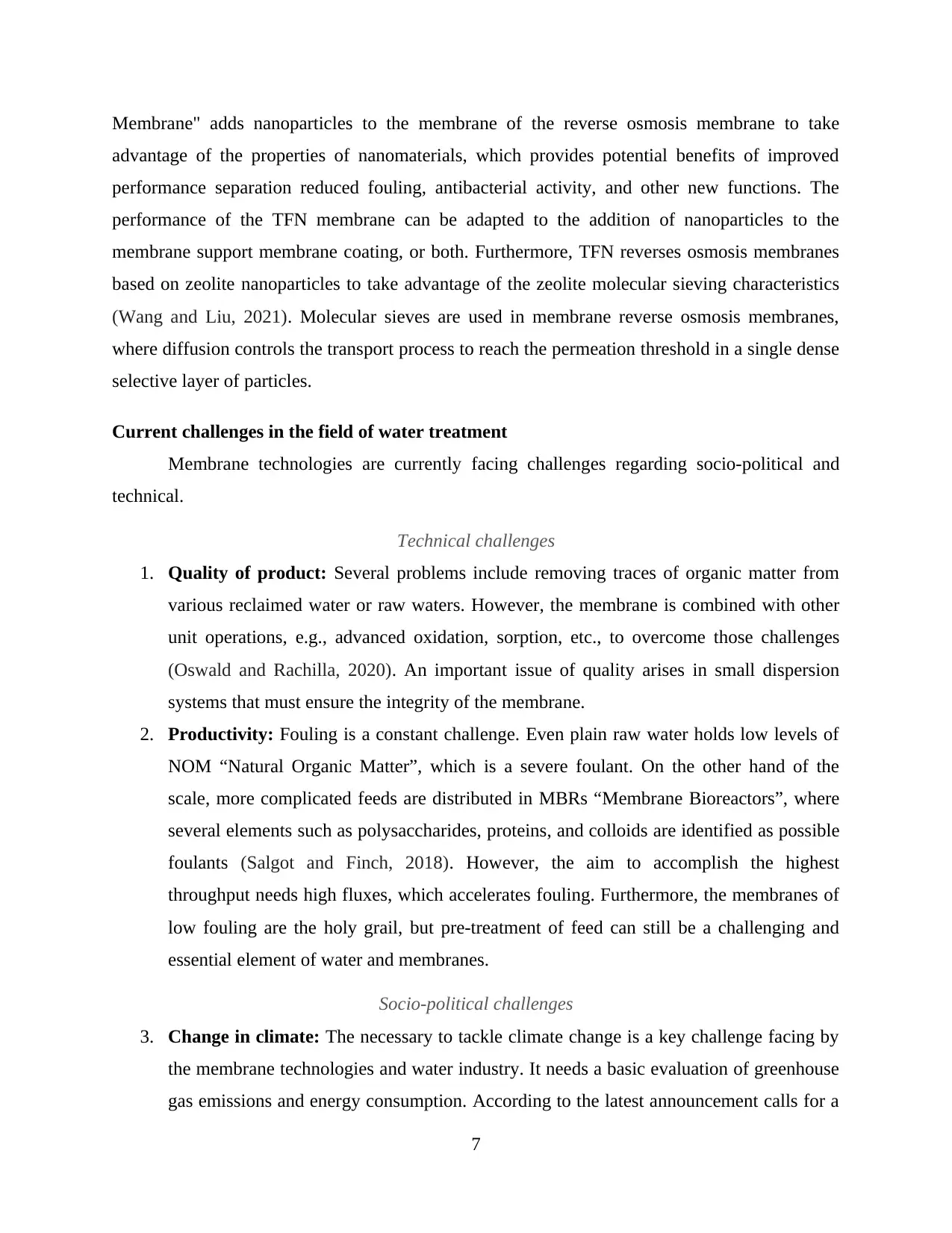
Membrane" adds nanoparticles to the membrane of the reverse osmosis membrane to take
advantage of the properties of nanomaterials, which provides potential benefits of improved
performance separation reduced fouling, antibacterial activity, and other new functions. The
performance of the TFN membrane can be adapted to the addition of nanoparticles to the
membrane support membrane coating, or both. Furthermore, TFN reverses osmosis membranes
based on zeolite nanoparticles to take advantage of the zeolite molecular sieving characteristics
(Wang and Liu, 2021). Molecular sieves are used in membrane reverse osmosis membranes,
where diffusion controls the transport process to reach the permeation threshold in a single dense
selective layer of particles.
Current challenges in the field of water treatment
Membrane technologies are currently facing challenges regarding socio-political and
technical.
Technical challenges
1. Quality of product: Several problems include removing traces of organic matter from
various reclaimed water or raw waters. However, the membrane is combined with other
unit operations, e.g., advanced oxidation, sorption, etc., to overcome those challenges
(Oswald and Rachilla, 2020). An important issue of quality arises in small dispersion
systems that must ensure the integrity of the membrane.
2. Productivity: Fouling is a constant challenge. Even plain raw water holds low levels of
NOM “Natural Organic Matter”, which is a severe foulant. On the other hand of the
scale, more complicated feeds are distributed in MBRs “Membrane Bioreactors”, where
several elements such as polysaccharides, proteins, and colloids are identified as possible
foulants (Salgot and Finch, 2018). However, the aim to accomplish the highest
throughput needs high fluxes, which accelerates fouling. Furthermore, the membranes of
low fouling are the holy grail, but pre-treatment of feed can still be a challenging and
essential element of water and membranes.
Socio-political challenges
3. Change in climate: The necessary to tackle climate change is a key challenge facing by
the membrane technologies and water industry. It needs a basic evaluation of greenhouse
gas emissions and energy consumption. According to the latest announcement calls for a
7
advantage of the properties of nanomaterials, which provides potential benefits of improved
performance separation reduced fouling, antibacterial activity, and other new functions. The
performance of the TFN membrane can be adapted to the addition of nanoparticles to the
membrane support membrane coating, or both. Furthermore, TFN reverses osmosis membranes
based on zeolite nanoparticles to take advantage of the zeolite molecular sieving characteristics
(Wang and Liu, 2021). Molecular sieves are used in membrane reverse osmosis membranes,
where diffusion controls the transport process to reach the permeation threshold in a single dense
selective layer of particles.
Current challenges in the field of water treatment
Membrane technologies are currently facing challenges regarding socio-political and
technical.
Technical challenges
1. Quality of product: Several problems include removing traces of organic matter from
various reclaimed water or raw waters. However, the membrane is combined with other
unit operations, e.g., advanced oxidation, sorption, etc., to overcome those challenges
(Oswald and Rachilla, 2020). An important issue of quality arises in small dispersion
systems that must ensure the integrity of the membrane.
2. Productivity: Fouling is a constant challenge. Even plain raw water holds low levels of
NOM “Natural Organic Matter”, which is a severe foulant. On the other hand of the
scale, more complicated feeds are distributed in MBRs “Membrane Bioreactors”, where
several elements such as polysaccharides, proteins, and colloids are identified as possible
foulants (Salgot and Finch, 2018). However, the aim to accomplish the highest
throughput needs high fluxes, which accelerates fouling. Furthermore, the membranes of
low fouling are the holy grail, but pre-treatment of feed can still be a challenging and
essential element of water and membranes.
Socio-political challenges
3. Change in climate: The necessary to tackle climate change is a key challenge facing by
the membrane technologies and water industry. It needs a basic evaluation of greenhouse
gas emissions and energy consumption. According to the latest announcement calls for a
7
Paraphrase This Document
Need a fresh take? Get an instant paraphrase of this document with our AI Paraphraser
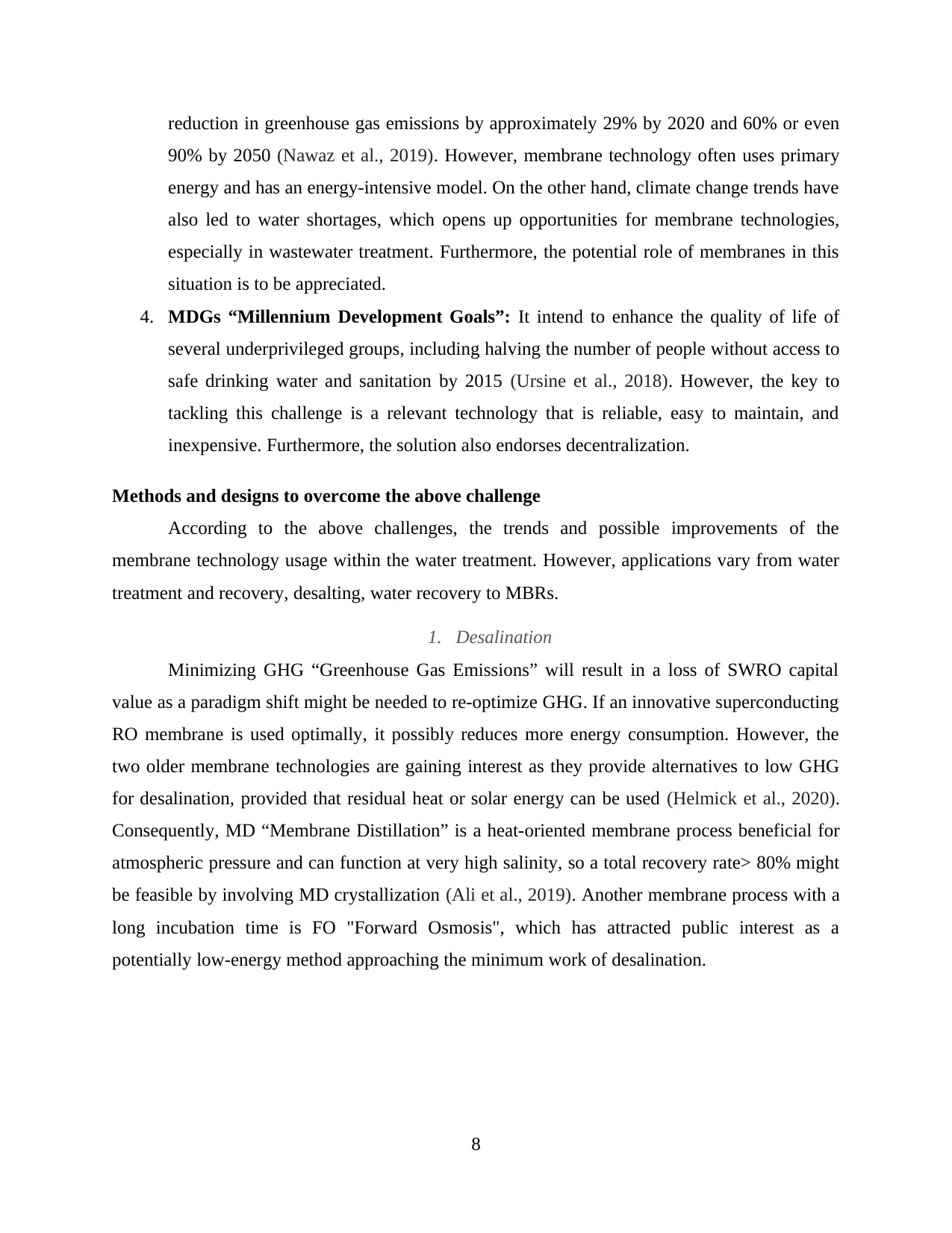
reduction in greenhouse gas emissions by approximately 29% by 2020 and 60% or even
90% by 2050 (Nawaz et al., 2019). However, membrane technology often uses primary
energy and has an energy-intensive model. On the other hand, climate change trends have
also led to water shortages, which opens up opportunities for membrane technologies,
especially in wastewater treatment. Furthermore, the potential role of membranes in this
situation is to be appreciated.
4. MDGs “Millennium Development Goals”: It intend to enhance the quality of life of
several underprivileged groups, including halving the number of people without access to
safe drinking water and sanitation by 2015 (Ursine et al., 2018). However, the key to
tackling this challenge is a relevant technology that is reliable, easy to maintain, and
inexpensive. Furthermore, the solution also endorses decentralization.
Methods and designs to overcome the above challenge
According to the above challenges, the trends and possible improvements of the
membrane technology usage within the water treatment. However, applications vary from water
treatment and recovery, desalting, water recovery to MBRs.
1. Desalination
Minimizing GHG “Greenhouse Gas Emissions” will result in a loss of SWRO capital
value as a paradigm shift might be needed to re-optimize GHG. If an innovative superconducting
RO membrane is used optimally, it possibly reduces more energy consumption. However, the
two older membrane technologies are gaining interest as they provide alternatives to low GHG
for desalination, provided that residual heat or solar energy can be used (Helmick et al., 2020).
Consequently, MD “Membrane Distillation” is a heat-oriented membrane process beneficial for
atmospheric pressure and can function at very high salinity, so a total recovery rate> 80% might
be feasible by involving MD crystallization (Ali et al., 2019). Another membrane process with a
long incubation time is FO "Forward Osmosis", which has attracted public interest as a
potentially low-energy method approaching the minimum work of desalination.
8
90% by 2050 (Nawaz et al., 2019). However, membrane technology often uses primary
energy and has an energy-intensive model. On the other hand, climate change trends have
also led to water shortages, which opens up opportunities for membrane technologies,
especially in wastewater treatment. Furthermore, the potential role of membranes in this
situation is to be appreciated.
4. MDGs “Millennium Development Goals”: It intend to enhance the quality of life of
several underprivileged groups, including halving the number of people without access to
safe drinking water and sanitation by 2015 (Ursine et al., 2018). However, the key to
tackling this challenge is a relevant technology that is reliable, easy to maintain, and
inexpensive. Furthermore, the solution also endorses decentralization.
Methods and designs to overcome the above challenge
According to the above challenges, the trends and possible improvements of the
membrane technology usage within the water treatment. However, applications vary from water
treatment and recovery, desalting, water recovery to MBRs.
1. Desalination
Minimizing GHG “Greenhouse Gas Emissions” will result in a loss of SWRO capital
value as a paradigm shift might be needed to re-optimize GHG. If an innovative superconducting
RO membrane is used optimally, it possibly reduces more energy consumption. However, the
two older membrane technologies are gaining interest as they provide alternatives to low GHG
for desalination, provided that residual heat or solar energy can be used (Helmick et al., 2020).
Consequently, MD “Membrane Distillation” is a heat-oriented membrane process beneficial for
atmospheric pressure and can function at very high salinity, so a total recovery rate> 80% might
be feasible by involving MD crystallization (Ali et al., 2019). Another membrane process with a
long incubation time is FO "Forward Osmosis", which has attracted public interest as a
potentially low-energy method approaching the minimum work of desalination.
8
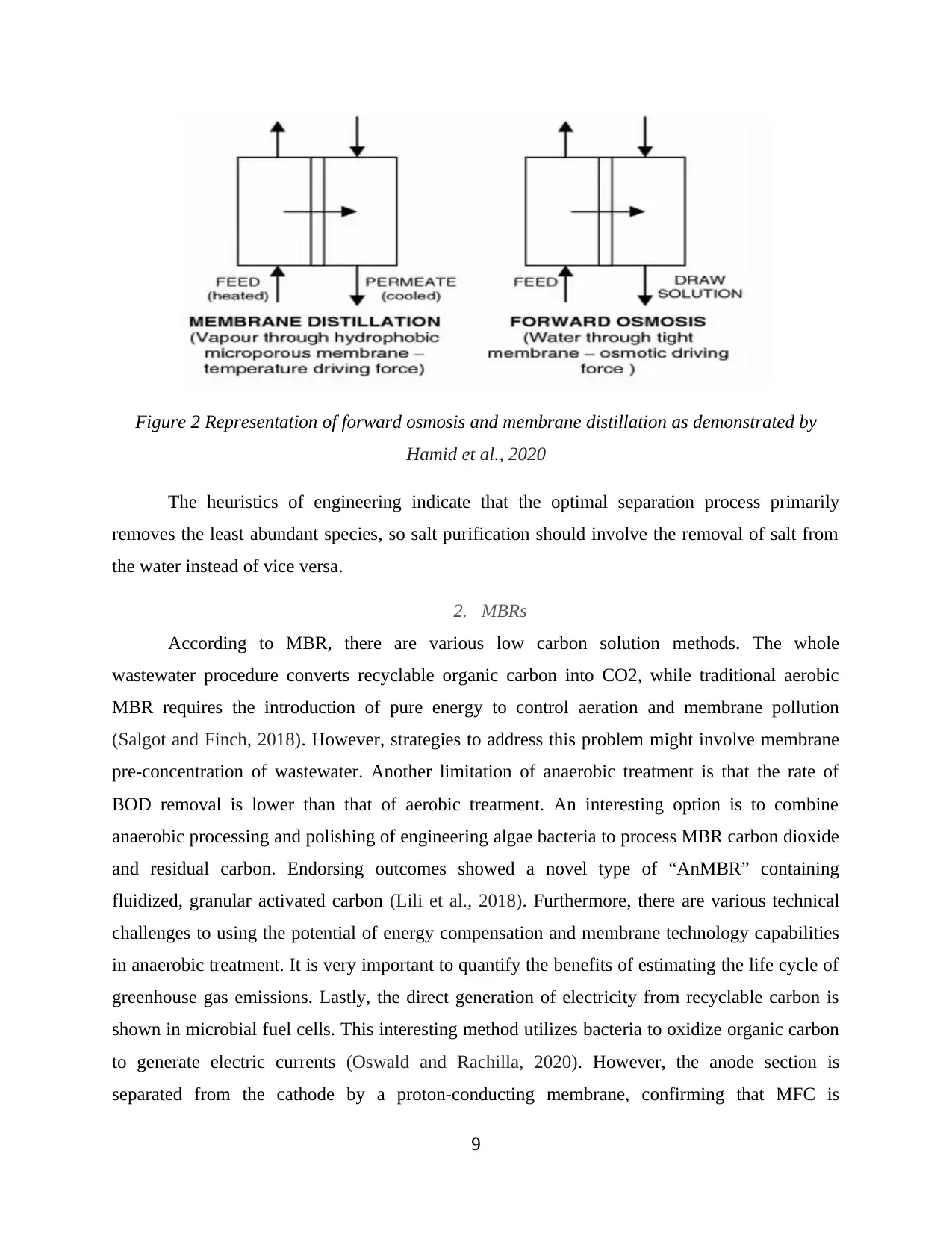
Figure 2 Representation of forward osmosis and membrane distillation as demonstrated by
Hamid et al., 2020
The heuristics of engineering indicate that the optimal separation process primarily
removes the least abundant species, so salt purification should involve the removal of salt from
the water instead of vice versa.
2. MBRs
According to MBR, there are various low carbon solution methods. The whole
wastewater procedure converts recyclable organic carbon into CO2, while traditional aerobic
MBR requires the introduction of pure energy to control aeration and membrane pollution
(Salgot and Finch, 2018). However, strategies to address this problem might involve membrane
pre-concentration of wastewater. Another limitation of anaerobic treatment is that the rate of
BOD removal is lower than that of aerobic treatment. An interesting option is to combine
anaerobic processing and polishing of engineering algae bacteria to process MBR carbon dioxide
and residual carbon. Endorsing outcomes showed a novel type of “AnMBR” containing
fluidized, granular activated carbon (Lili et al., 2018). Furthermore, there are various technical
challenges to using the potential of energy compensation and membrane technology capabilities
in anaerobic treatment. It is very important to quantify the benefits of estimating the life cycle of
greenhouse gas emissions. Lastly, the direct generation of electricity from recyclable carbon is
shown in microbial fuel cells. This interesting method utilizes bacteria to oxidize organic carbon
to generate electric currents (Oswald and Rachilla, 2020). However, the anode section is
separated from the cathode by a proton-conducting membrane, confirming that MFC is
9
Hamid et al., 2020
The heuristics of engineering indicate that the optimal separation process primarily
removes the least abundant species, so salt purification should involve the removal of salt from
the water instead of vice versa.
2. MBRs
According to MBR, there are various low carbon solution methods. The whole
wastewater procedure converts recyclable organic carbon into CO2, while traditional aerobic
MBR requires the introduction of pure energy to control aeration and membrane pollution
(Salgot and Finch, 2018). However, strategies to address this problem might involve membrane
pre-concentration of wastewater. Another limitation of anaerobic treatment is that the rate of
BOD removal is lower than that of aerobic treatment. An interesting option is to combine
anaerobic processing and polishing of engineering algae bacteria to process MBR carbon dioxide
and residual carbon. Endorsing outcomes showed a novel type of “AnMBR” containing
fluidized, granular activated carbon (Lili et al., 2018). Furthermore, there are various technical
challenges to using the potential of energy compensation and membrane technology capabilities
in anaerobic treatment. It is very important to quantify the benefits of estimating the life cycle of
greenhouse gas emissions. Lastly, the direct generation of electricity from recyclable carbon is
shown in microbial fuel cells. This interesting method utilizes bacteria to oxidize organic carbon
to generate electric currents (Oswald and Rachilla, 2020). However, the anode section is
separated from the cathode by a proton-conducting membrane, confirming that MFC is
9
⊘ This is a preview!⊘
Do you want full access?
Subscribe today to unlock all pages.

Trusted by 1+ million students worldwide
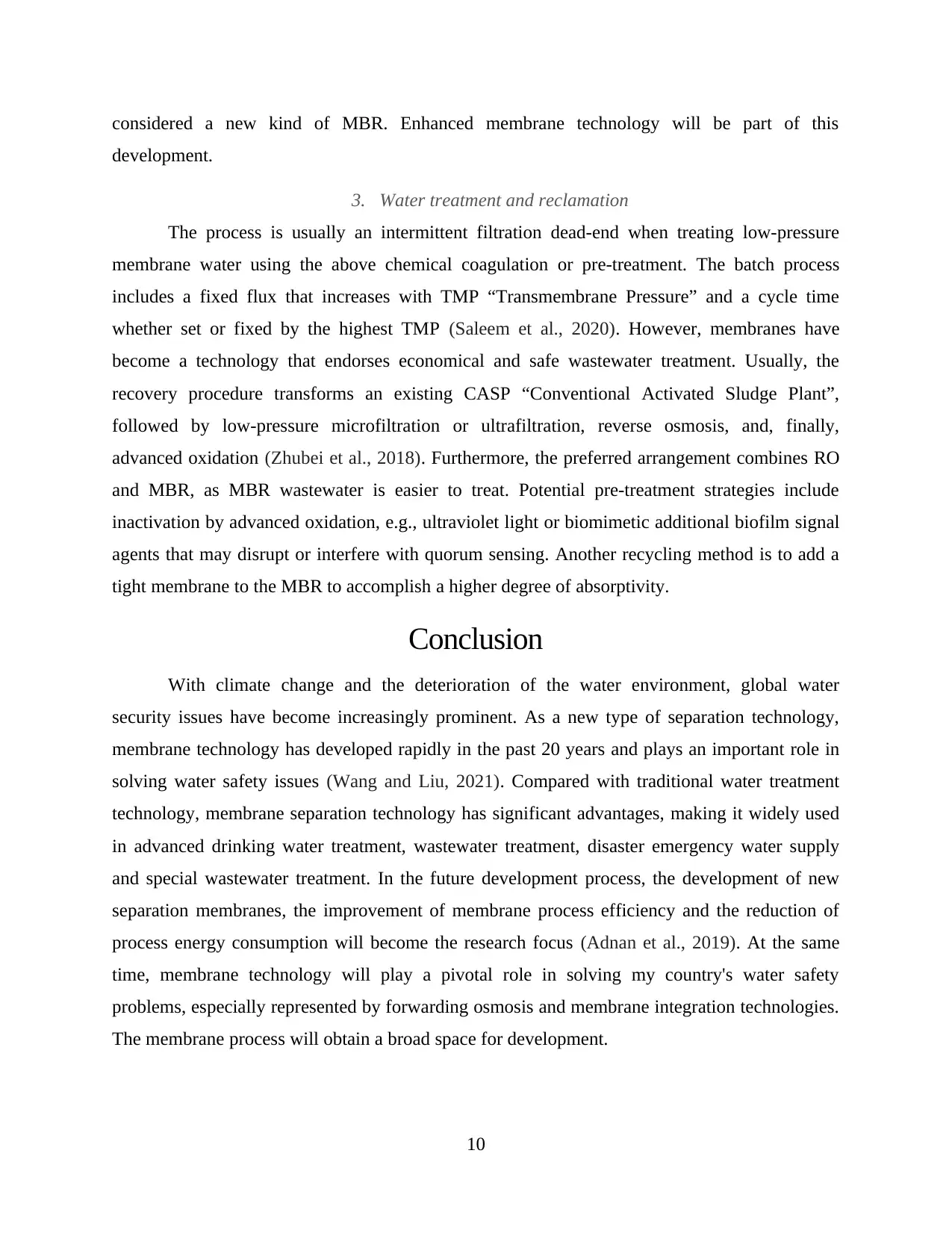
considered a new kind of MBR. Enhanced membrane technology will be part of this
development.
3. Water treatment and reclamation
The process is usually an intermittent filtration dead-end when treating low-pressure
membrane water using the above chemical coagulation or pre-treatment. The batch process
includes a fixed flux that increases with TMP “Transmembrane Pressure” and a cycle time
whether set or fixed by the highest TMP (Saleem et al., 2020). However, membranes have
become a technology that endorses economical and safe wastewater treatment. Usually, the
recovery procedure transforms an existing CASP “Conventional Activated Sludge Plant”,
followed by low-pressure microfiltration or ultrafiltration, reverse osmosis, and, finally,
advanced oxidation (Zhubei et al., 2018). Furthermore, the preferred arrangement combines RO
and MBR, as MBR wastewater is easier to treat. Potential pre-treatment strategies include
inactivation by advanced oxidation, e.g., ultraviolet light or biomimetic additional biofilm signal
agents that may disrupt or interfere with quorum sensing. Another recycling method is to add a
tight membrane to the MBR to accomplish a higher degree of absorptivity.
Conclusion
With climate change and the deterioration of the water environment, global water
security issues have become increasingly prominent. As a new type of separation technology,
membrane technology has developed rapidly in the past 20 years and plays an important role in
solving water safety issues (Wang and Liu, 2021). Compared with traditional water treatment
technology, membrane separation technology has significant advantages, making it widely used
in advanced drinking water treatment, wastewater treatment, disaster emergency water supply
and special wastewater treatment. In the future development process, the development of new
separation membranes, the improvement of membrane process efficiency and the reduction of
process energy consumption will become the research focus (Adnan et al., 2019). At the same
time, membrane technology will play a pivotal role in solving my country's water safety
problems, especially represented by forwarding osmosis and membrane integration technologies.
The membrane process will obtain a broad space for development.
10
development.
3. Water treatment and reclamation
The process is usually an intermittent filtration dead-end when treating low-pressure
membrane water using the above chemical coagulation or pre-treatment. The batch process
includes a fixed flux that increases with TMP “Transmembrane Pressure” and a cycle time
whether set or fixed by the highest TMP (Saleem et al., 2020). However, membranes have
become a technology that endorses economical and safe wastewater treatment. Usually, the
recovery procedure transforms an existing CASP “Conventional Activated Sludge Plant”,
followed by low-pressure microfiltration or ultrafiltration, reverse osmosis, and, finally,
advanced oxidation (Zhubei et al., 2018). Furthermore, the preferred arrangement combines RO
and MBR, as MBR wastewater is easier to treat. Potential pre-treatment strategies include
inactivation by advanced oxidation, e.g., ultraviolet light or biomimetic additional biofilm signal
agents that may disrupt or interfere with quorum sensing. Another recycling method is to add a
tight membrane to the MBR to accomplish a higher degree of absorptivity.
Conclusion
With climate change and the deterioration of the water environment, global water
security issues have become increasingly prominent. As a new type of separation technology,
membrane technology has developed rapidly in the past 20 years and plays an important role in
solving water safety issues (Wang and Liu, 2021). Compared with traditional water treatment
technology, membrane separation technology has significant advantages, making it widely used
in advanced drinking water treatment, wastewater treatment, disaster emergency water supply
and special wastewater treatment. In the future development process, the development of new
separation membranes, the improvement of membrane process efficiency and the reduction of
process energy consumption will become the research focus (Adnan et al., 2019). At the same
time, membrane technology will play a pivotal role in solving my country's water safety
problems, especially represented by forwarding osmosis and membrane integration technologies.
The membrane process will obtain a broad space for development.
10
Paraphrase This Document
Need a fresh take? Get an instant paraphrase of this document with our AI Paraphraser
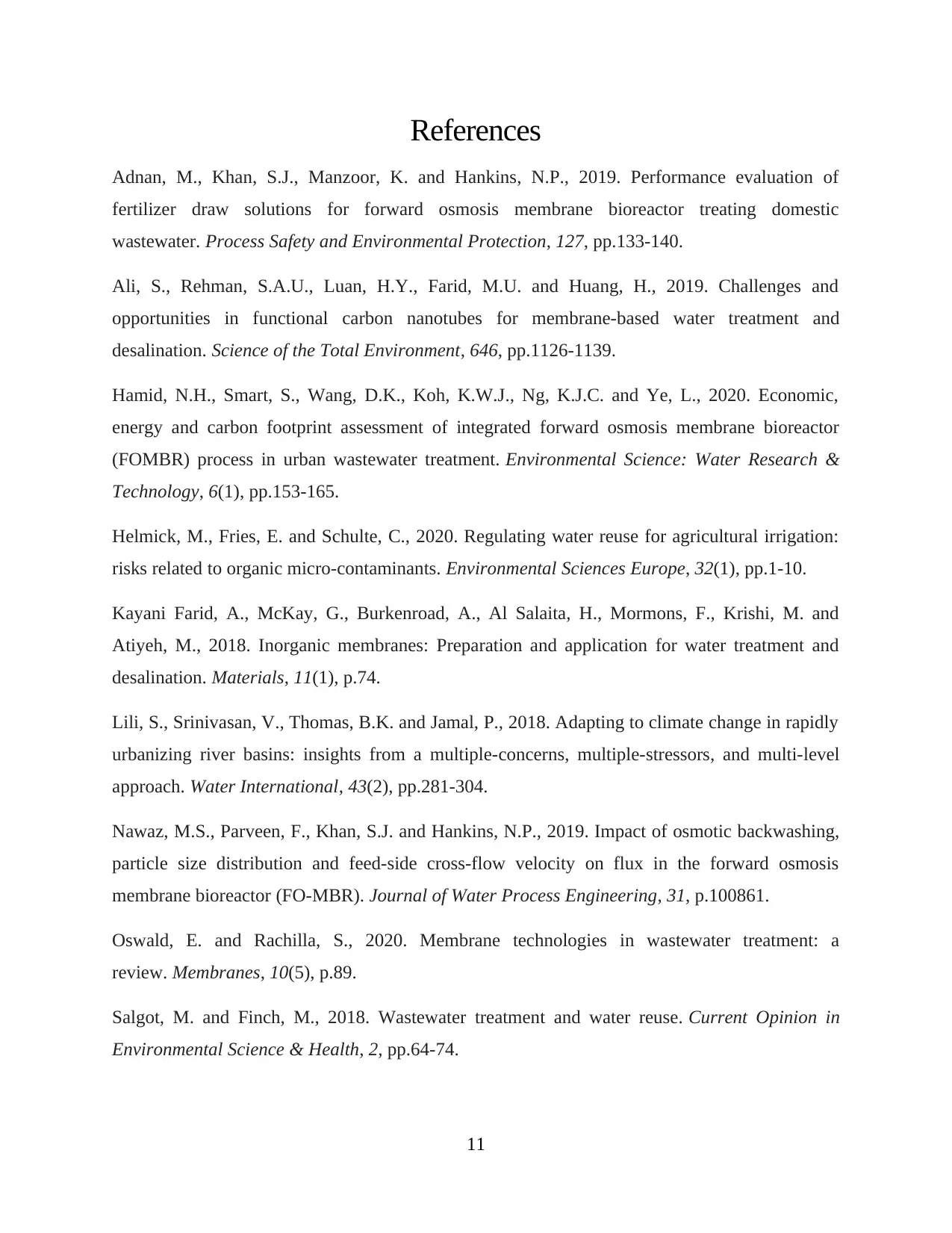
References
Adnan, M., Khan, S.J., Manzoor, K. and Hankins, N.P., 2019. Performance evaluation of
fertilizer draw solutions for forward osmosis membrane bioreactor treating domestic
wastewater. Process Safety and Environmental Protection, 127, pp.133-140.
Ali, S., Rehman, S.A.U., Luan, H.Y., Farid, M.U. and Huang, H., 2019. Challenges and
opportunities in functional carbon nanotubes for membrane-based water treatment and
desalination. Science of the Total Environment, 646, pp.1126-1139.
Hamid, N.H., Smart, S., Wang, D.K., Koh, K.W.J., Ng, K.J.C. and Ye, L., 2020. Economic,
energy and carbon footprint assessment of integrated forward osmosis membrane bioreactor
(FOMBR) process in urban wastewater treatment. Environmental Science: Water Research &
Technology, 6(1), pp.153-165.
Helmick, M., Fries, E. and Schulte, C., 2020. Regulating water reuse for agricultural irrigation:
risks related to organic micro-contaminants. Environmental Sciences Europe, 32(1), pp.1-10.
Kayani Farid, A., McKay, G., Burkenroad, A., Al Salaita, H., Mormons, F., Krishi, M. and
Atiyeh, M., 2018. Inorganic membranes: Preparation and application for water treatment and
desalination. Materials, 11(1), p.74.
Lili, S., Srinivasan, V., Thomas, B.K. and Jamal, P., 2018. Adapting to climate change in rapidly
urbanizing river basins: insights from a multiple-concerns, multiple-stressors, and multi-level
approach. Water International, 43(2), pp.281-304.
Nawaz, M.S., Parveen, F., Khan, S.J. and Hankins, N.P., 2019. Impact of osmotic backwashing,
particle size distribution and feed-side cross-flow velocity on flux in the forward osmosis
membrane bioreactor (FO-MBR). Journal of Water Process Engineering, 31, p.100861.
Oswald, E. and Rachilla, S., 2020. Membrane technologies in wastewater treatment: a
review. Membranes, 10(5), p.89.
Salgot, M. and Finch, M., 2018. Wastewater treatment and water reuse. Current Opinion in
Environmental Science & Health, 2, pp.64-74.
11
Adnan, M., Khan, S.J., Manzoor, K. and Hankins, N.P., 2019. Performance evaluation of
fertilizer draw solutions for forward osmosis membrane bioreactor treating domestic
wastewater. Process Safety and Environmental Protection, 127, pp.133-140.
Ali, S., Rehman, S.A.U., Luan, H.Y., Farid, M.U. and Huang, H., 2019. Challenges and
opportunities in functional carbon nanotubes for membrane-based water treatment and
desalination. Science of the Total Environment, 646, pp.1126-1139.
Hamid, N.H., Smart, S., Wang, D.K., Koh, K.W.J., Ng, K.J.C. and Ye, L., 2020. Economic,
energy and carbon footprint assessment of integrated forward osmosis membrane bioreactor
(FOMBR) process in urban wastewater treatment. Environmental Science: Water Research &
Technology, 6(1), pp.153-165.
Helmick, M., Fries, E. and Schulte, C., 2020. Regulating water reuse for agricultural irrigation:
risks related to organic micro-contaminants. Environmental Sciences Europe, 32(1), pp.1-10.
Kayani Farid, A., McKay, G., Burkenroad, A., Al Salaita, H., Mormons, F., Krishi, M. and
Atiyeh, M., 2018. Inorganic membranes: Preparation and application for water treatment and
desalination. Materials, 11(1), p.74.
Lili, S., Srinivasan, V., Thomas, B.K. and Jamal, P., 2018. Adapting to climate change in rapidly
urbanizing river basins: insights from a multiple-concerns, multiple-stressors, and multi-level
approach. Water International, 43(2), pp.281-304.
Nawaz, M.S., Parveen, F., Khan, S.J. and Hankins, N.P., 2019. Impact of osmotic backwashing,
particle size distribution and feed-side cross-flow velocity on flux in the forward osmosis
membrane bioreactor (FO-MBR). Journal of Water Process Engineering, 31, p.100861.
Oswald, E. and Rachilla, S., 2020. Membrane technologies in wastewater treatment: a
review. Membranes, 10(5), p.89.
Salgot, M. and Finch, M., 2018. Wastewater treatment and water reuse. Current Opinion in
Environmental Science & Health, 2, pp.64-74.
11
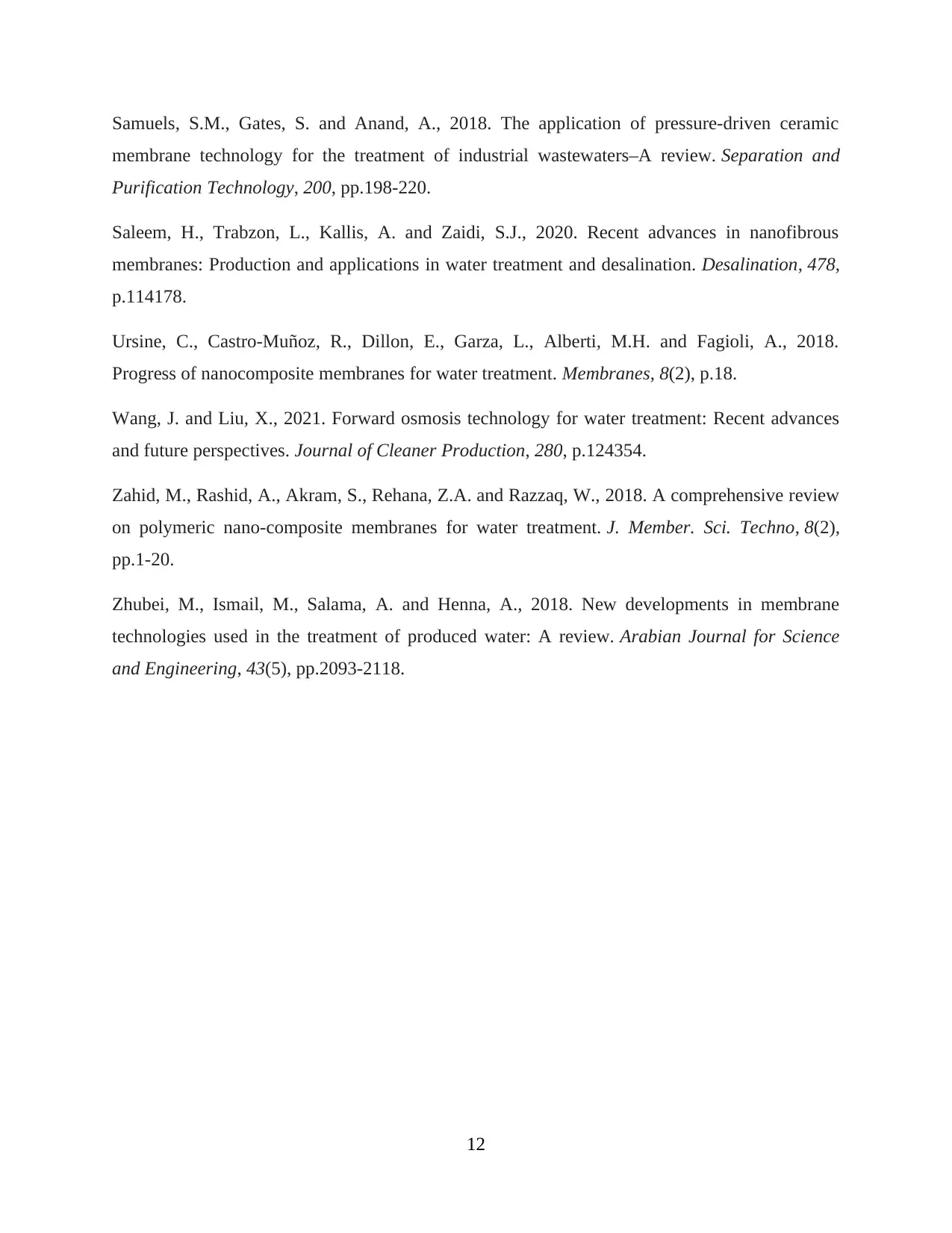
Samuels, S.M., Gates, S. and Anand, A., 2018. The application of pressure-driven ceramic
membrane technology for the treatment of industrial wastewaters–A review. Separation and
Purification Technology, 200, pp.198-220.
Saleem, H., Trabzon, L., Kallis, A. and Zaidi, S.J., 2020. Recent advances in nanofibrous
membranes: Production and applications in water treatment and desalination. Desalination, 478,
p.114178.
Ursine, C., Castro-Muñoz, R., Dillon, E., Garza, L., Alberti, M.H. and Fagioli, A., 2018.
Progress of nanocomposite membranes for water treatment. Membranes, 8(2), p.18.
Wang, J. and Liu, X., 2021. Forward osmosis technology for water treatment: Recent advances
and future perspectives. Journal of Cleaner Production, 280, p.124354.
Zahid, M., Rashid, A., Akram, S., Rehana, Z.A. and Razzaq, W., 2018. A comprehensive review
on polymeric nano-composite membranes for water treatment. J. Member. Sci. Techno, 8(2),
pp.1-20.
Zhubei, M., Ismail, M., Salama, A. and Henna, A., 2018. New developments in membrane
technologies used in the treatment of produced water: A review. Arabian Journal for Science
and Engineering, 43(5), pp.2093-2118.
12
membrane technology for the treatment of industrial wastewaters–A review. Separation and
Purification Technology, 200, pp.198-220.
Saleem, H., Trabzon, L., Kallis, A. and Zaidi, S.J., 2020. Recent advances in nanofibrous
membranes: Production and applications in water treatment and desalination. Desalination, 478,
p.114178.
Ursine, C., Castro-Muñoz, R., Dillon, E., Garza, L., Alberti, M.H. and Fagioli, A., 2018.
Progress of nanocomposite membranes for water treatment. Membranes, 8(2), p.18.
Wang, J. and Liu, X., 2021. Forward osmosis technology for water treatment: Recent advances
and future perspectives. Journal of Cleaner Production, 280, p.124354.
Zahid, M., Rashid, A., Akram, S., Rehana, Z.A. and Razzaq, W., 2018. A comprehensive review
on polymeric nano-composite membranes for water treatment. J. Member. Sci. Techno, 8(2),
pp.1-20.
Zhubei, M., Ismail, M., Salama, A. and Henna, A., 2018. New developments in membrane
technologies used in the treatment of produced water: A review. Arabian Journal for Science
and Engineering, 43(5), pp.2093-2118.
12
⊘ This is a preview!⊘
Do you want full access?
Subscribe today to unlock all pages.

Trusted by 1+ million students worldwide
1 out of 12
Your All-in-One AI-Powered Toolkit for Academic Success.
+13062052269
info@desklib.com
Available 24*7 on WhatsApp / Email
![[object Object]](/_next/static/media/star-bottom.7253800d.svg)
Unlock your academic potential
Copyright © 2020–2025 A2Z Services. All Rights Reserved. Developed and managed by ZUCOL.
